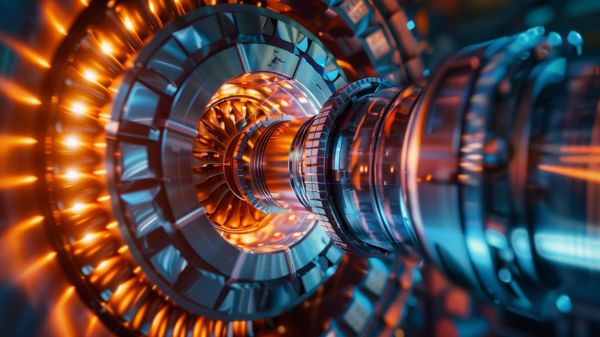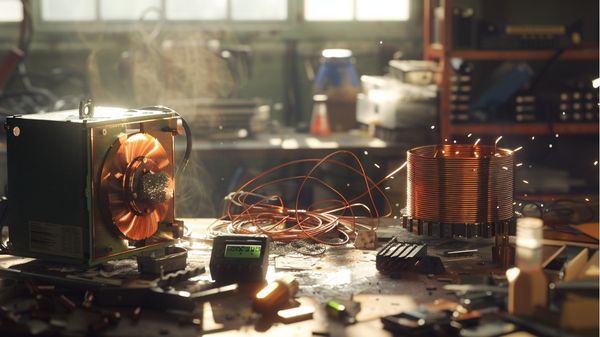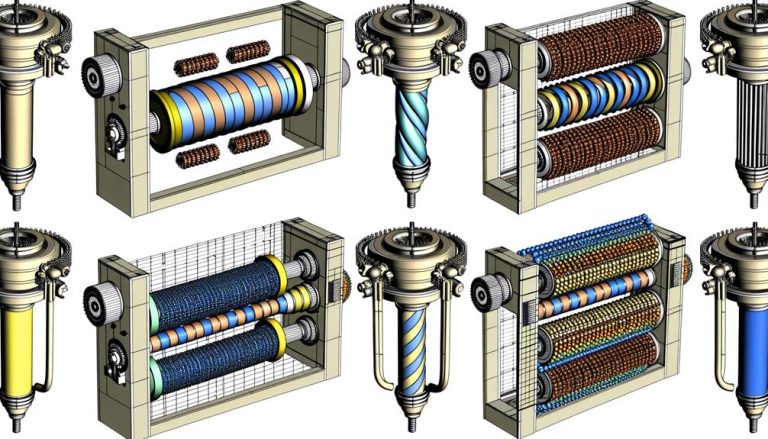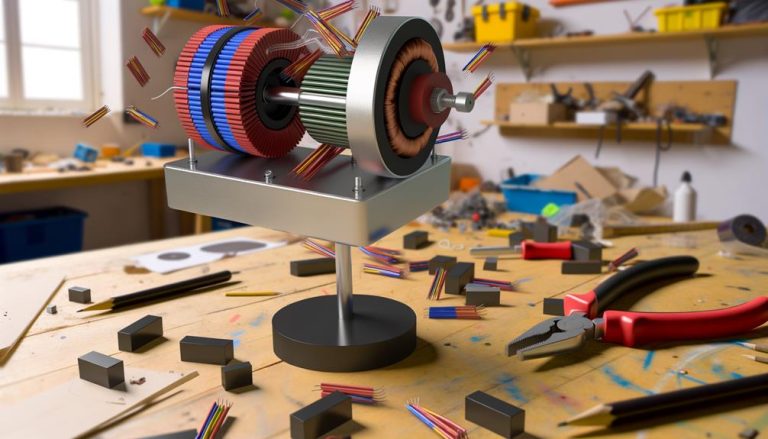In an era where sustainable energy solutions are paramount, magnetic power generators stand as a pivotal technology in the conversion of mechanical energy into electricity. This guide unpacks the mechanics behind these generators, elucidating the principles of magnetic fields, electromagnetic induction, and kinetic energy conversion.
From the roles of magnets in wind and geothermal power generation to the distinctions between permanent and induction generators, the potential for environmental impact and sustainability is immense. To grasp the full scope of how these components and processes interlink to drive renewable energy forward, a deeper exploration is essential.
Understanding Magnetic Power Generators
Magnetic power generators, essential components in modern energy systems, convert mechanical energy into electricity through the interaction of magnetic fields and electrical conductors. These generators play a pivotal role in various applications, including wind turbines, steam turbines, gas turbines, and engines. The efficiency and reliability of magnetic power generators stem from their ability to operate without an external current supply, ensuring continuous energy conversion under diverse conditions.
Permanent magnet generators are a specific type of magnetic power generator that employs high-performance materials such as neodymium, samarium-cobalt, ferrite, and aluminum-nickel-cobalt. These materials are selected for their superior magnetic properties, which enhance the overall efficiency and durability of the generators. The primary components of these generators include stators and rotors, which are meticulously designed to optimize the interaction between the magnetic fields and electrical conductors.
The practical applications of magnetic power generators extend beyond traditional energy systems. Their ability to provide consistent and reliable electricity makes them ideal for remote and off-grid locations, aligning with the aspirations of those seeking energy independence and sustainability. By harnessing the inherent properties of permanent magnets, these generators offer a robust solution for modern energy challenges.
⚡OFF-GRID POWER⚡
Build a Home Power Backup—No Utility Needed
Looking to keep essentials running during outages? The Ultimate Off-Grid Generator course walks you through a DIY backup system with simple parts and step-by-step plans — ideal for homesteads, cabins, or emergency prep.
Can Magnets Generate Electricity?
While magnets themselves do not generate electricity, they are integral in the electromagnetic induction process, where kinetic energy is converted into electrical energy.
This conversion occurs through the interaction between a moving magnetic field and conductive materials, inducing an electric current.
Practical applications of this principle are evident in wind turbines and hydroelectric generators, where magnets facilitate the transformation of mechanical motion into electrical power.
Electromagnetic Induction Process
Electromagnetic induction, a cornerstone of modern power generation, involves generating an electric current by moving a magnetic field relative to a conductor, converting kinetic energy into electrical energy.
This process is crucial to the functionality of generators, which are at the heart of numerous power generation systems including wind turbines and hydroelectric plants. By leveraging the principles of electromagnetic induction, these systems efficiently convert mechanical motion into usable electrical power.
The interaction between the magnetic field and the conductor is precisely engineered to maximize energy conversion efficiency. Magnets, integral to this process, create the magnetic field necessary for inducing an electric current. When a conductor, such as a coil of wire, moves through this magnetic field, an electromotive force (EMF) is generated, resulting in electricity.
| Component | Role | Example |
|---|---|---|
| Magnetic Field | Induces EMF in the conductor | Magnets in generators |
| Conductor | Pathway for electric current | Copper coils in turbines |
| Mechanical Motion | Provides kinetic energy for induction | Rotating blades in wind farms |
Understanding electromagnetic induction equips us to harness renewable energy sources effectively, driving innovation and sustainability. This knowledge empowers individuals and industries to move towards a future of liberated, clean energy production.
Conversion of Kinetic Energy
Harnessing kinetic energy to generate electricity fundamentally relies on the strategic use of magnets within the framework of electromagnetic induction. This process involves the conversion of kinetic energy into electrical energy by exploiting magnetic fields. Magnets are pivotal in this conversion, as they facilitate the movement of electrons, thereby generating an electric current.
Here, we will explore the detailed mechanisms and practical applications of this process.
- Magnetic Field Generation: Magnets create a magnetic field, which is essential for influencing the movement of electrons within a conductor.
- Electromagnetic Induction: When a conductor moves through a magnetic field, electromagnetic induction occurs, causing electrons in the conductor to move and generate an electric current.
- Kinetic Energy Sources: Various kinetic energy sources, such as wind and water, are harnessed to move conductors through magnetic fields, exemplified in wind turbines and hydroelectric plants.
- Power Generation: Mainstream power generation methods, including renewable energy systems, utilize magnets to convert kinetic energy effectively into electrical energy, thereby promoting sustainable energy solutions.
Related Post: The Role of Magnets in Transforming Kinetic Energy Into Electricity.
Electromagnetic Induction Explained
Electromagnetic induction, discovered by Michael Faraday in 1831, is the fundamental principle behind the generation of electrical energy in magnetic power generators.
This process involves creating an electric current by moving a conductor through a magnetic field, thereby converting mechanical energy into electrical energy.
Practical applications of this principle are evident in various power generation systems, such as wind turbines and hydroelectric plants, where it enables efficient and sustainable electricity production.
Basics of Electromagnetic Induction
The fundamental process of generating electric current through the movement of a conductor in a magnetic field, known as electromagnetic induction, serves as the cornerstone for numerous modern electrical technologies. Discovered by Michael Faraday in 1831, this phenomenon reveals the intricate relationship between magnetism and electricity.
At its core, electromagnetic induction involves creating a voltage difference, or electromotive force (EMF), when magnetic lines of force intersect with a conductor, resulting in the flow of electric current.
To explore further into this concept, consider the following essential components:
- Magnetic Field Interaction: The presence of a magnetic field is vital, as it provides the necessary magnetic lines of force that interact with the conductor.
- Conductor Movement: The conductor must be in motion relative to the magnetic field to induce an electric current, which can be achieved through mechanical motion or varying the magnetic field itself.
- Induced Voltage: The interaction between the magnetic field and the conductor generates a voltage difference across the conductor’s ends, prompting the flow of electric current.
- Practical Devices: Electromagnetic induction underpins the operation of power plants, electric motors, and transformers, enabling efficient energy conversion and widespread electrical applications.
Understanding these principles can empower individuals to utilize electromagnetic induction for innovative and efficient energy solutions.
Practical Applications Explained
Many of today’s essential energy conversion technologies, such as wind turbines and hydroelectric power plants, rely fundamentally on the principles of electromagnetic induction to generate electricity efficiently and sustainably. This process, elucidated by Faraday’s law, involves generating an electric current by moving a conductor through a magnetic field, converting kinetic energy into electrical energy.
In wind turbines, the kinetic energy of wind rotates the turbine blades, which connect to a rotor. This rotor, in turn, moves within a magnetic field created by either permanent magnets or electromagnets, inducing an electromotive force (EMF) in the conductors of the generator. The induced current is then harnessed for power generation, making wind turbines a pivotal component in the utilization of renewable energy sources.
Similarly, hydroelectric power plants operate by channeling water flow to spin turbines connected to generators. The movement of these turbines within a magnetic field induces electric currents, adhering to the same principles of electromagnetic induction. Through Lenz’s law, the direction of the induced current opposes the change in magnetic flux, ensuring efficient energy conversion.
Understanding and implementing these principles of magnetic power are essential for advancing the efficiency and sustainability of renewable energy sources, thereby liberating society from reliance on fossil fuels.
Role of Magnets in Renewable Energy
In renewable energy systems like wind and hydroelectric power, magnets play an important role by converting kinetic energy into electrical energy with high efficiency.
These systems leverage the fundamental properties of magnets to facilitate the transformation of mechanical motion into usable power, enabling a sustainable approach to power generation. This conversion process is essential for achieving high efficiency and reliability in renewable energy frameworks.
- Kinetic to Electric Conversion: In hydroelectric power plants, flowing water spins turbines which, in turn, rotate magnets within a generator. This motion induces an electric current, effectively converting kinetic energy into electrical energy.
- Gearbox Reduction in Wind Turbines: Offshore wind turbines exploit magnets to eliminate the need for complex gearbox assemblies, thereby enhancing reliability and decreasing maintenance costs. This simplification results in more durable and efficient wind energy systems.
- Energy Efficiency: Magnets contribute to higher efficiency rates in renewable energy systems by minimizing energy loss during the conversion process. This efficiency is important for maximizing the output from renewable sources.
- Regional Impact: In 2022, Washington state generated 67% of its electricity from hydroelectric power, exemplifying the significant role magnets play in regional renewable energy production.
Understanding the intricacies of how magnets function within these systems empowers stakeholders to optimize renewable energy solutions, fostering a more sustainable and liberated energy landscape.
⚡OFF-GRID POWER⚡
Build a Home Power Backup—No Utility Needed
Looking to keep essentials running during outages? The Ultimate Off-Grid Generator course walks you through a DIY backup system with simple parts and step-by-step plans — ideal for homesteads, cabins, or emergency prep.
Wind Turbines and Magnets
Wind turbines harness kinetic energy from wind, utilizing large magnets to convert this energy into electricity with fewer moving parts, thereby enhancing reliability.
The integration of magnets in turbine design is particularly advantageous for offshore installations, where gearbox assemblies are less efficient and harder to maintain.
Consequently, magnetic systems in wind turbines contribute notably to the growing sector of renewable wind power, offering practical solutions for sustainable energy generation.
Kinetic Energy Conversion
Harnessing the kinetic energy from wind turbines involves sophisticated engineering, particularly the use of powerful magnets to convert mechanical motion into electrical energy. This conversion process is essential for the efficient production of electricity and involves several critical components and mechanisms.
- Rotor and Stator Interaction: At the heart of wind turbines, powerful magnets are embedded within the rotor, which spins as the turbine blades turn. These magnets interact with the stator, a stationary set of coils, to induce an electric current through electromagnetic induction.
- Direct Drive Systems: Modern wind turbines increasingly favor direct drive systems over traditional gearbox assemblies. Large magnets in these systems eliminate the need for gearboxes, thereby enhancing efficiency and decreasing the mechanical complexity and maintenance requirements.
- Offshore Applications: Offshore wind turbines leverage the reliability of magnetic systems to reduce maintenance challenges posed by harsh marine environments. The robustness of magnets helps guarantee continuous operation and longevity of these installations.
- Energy Output Optimization: The configuration and quality of magnets within wind turbines directly influence the efficiency of kinetic energy conversion. By optimizing the magnetic properties and arrangement, the overall energy output of wind turbines can be greatly improved.
Enhanced Turbine Reliability
Utilizing large magnets in wind turbines greatly enhances turbine reliability by reducing the number of moving parts and minimizing maintenance needs. This innovation addresses an important issue in the domain of renewable energy: the durability and efficiency of wind turbines, particularly in challenging offshore environments.
By eliminating gearboxes, which are prone to wear and tear, the integration of magnets significantly boosts the reliability of turbines.
Offshore wind turbines, exposed to harsh conditions, benefit immensely from this technological advancement. The magnets facilitate smoother operations, ensuring that the kinetic energy generated by the turbine blades is efficiently converted into electricity. This not only optimizes the energy output but also extends the lifespan of the turbines, making them a more sustainable option for generating electricity.
Maintenance, a significant challenge for offshore installations, is simplified with magnetic systems. The reduced mechanical complexity means fewer components are susceptible to failure, ensuring more consistent and reliable energy production. This reliability is vital for achieving energy liberation, as it guarantees a stable supply of renewable energy with minimal interruptions.
Hydroelectric Power and Magnets
In the field of hydroelectric power, magnets play a crucial role in the conversion of kinetic energy from flowing water into electrical energy, achieved through the spinning of turbines. This process leverages the principles of electromagnetism to generate electricity efficiently.
Hydroelectric power is a cornerstone of renewable energy, evidenced by Washington state producing 67% of its electricity from this source in 2022. The integration of magnets within turbines is essential for this energy conversion process, enhancing reliability and efficiency.
Key aspects of hydroelectric power and magnets include:
- Turbine Mechanics: The kinetic energy of flowing water is harnessed to spin turbines embedded with magnets, which generate an electric current through electromagnetic induction.
- Energy Efficiency: Hydroelectric power plants, typically situated within dams, use the natural flow of water to produce electricity with minimal environmental impact, reducing reliance on fossil fuels.
- Sustainability: As a renewable energy source, hydroelectric power contributes to long-term energy sustainability and environmental stewardship.
- Technological Innovations: Advances in turbine design and magnetic materials continue to improve the efficiency and output of hydroelectric power plants, ensuring their role in future energy grids.
This detailed understanding underscores the transformative potential of hydroelectric power in achieving a liberated, sustainable energy future.
Geothermal Power Generation
Expanding the scope of renewable energy technologies, geothermal power generation leverages the Earth’s internal heat to produce electricity through the use of steam or hot water from underground reservoirs.
Geothermal power plants operate by channeling underground steam to spin turbines, thereby converting kinetic energy into electrical power. This method is both efficient and sustainable, providing a reliable energy source that can operate continuously at full capacity.
The United States stands as a significant producer of geothermal energy, with numerous operational plants contributing to the grid. One of the key advantages of geothermal power is its consistent power output, which helps to fill gaps left by other intermittent renewable energy sources like solar and wind. This makes geothermal energy an essential component in the shift to a more resilient and sustainable energy grid.
| Parameter | Details | Implications |
|---|---|---|
| Energy Source | Underground steam or hot water | Sustainable and abundant |
| Operational Hours | Almost 24/7 | Reliable energy source |
| Energy Conversion | Steam spins turbine to generate electricity | Efficient mechanism |
Permanent Magnet Generators Overview
Permanent magnet generators, crucial for converting mechanical energy into electrical power via magnetic fields, play a significant role in various applications, including wind, steam, and gas turbines, as well as internal combustion engines. These generators are characterized by their ability to operate without an external power supply, thanks to the inherent properties of the materials used in their construction.
The core components of permanent magnet generators are the stator and rotor. The rotor, equipped with permanent magnets made from materials like neodymium, samarium-cobalt, ferrite, and aluminum-nickel-cobalt, creates a stable magnetic field. This magnetic field interacts with the stator, which contains windings of conductive wire, to induce an electrical current as the rotor turns.
Advantages of permanent magnet generators include:
- Efficiency: Due to the absence of additional current supply requirements, these generators demonstrate high energy conversion efficiency.
- Reliability: The use of durable magnetic materials ensures a long operational life and minimal maintenance.
- Compactness: Their design allows for a reduction in size, making them suitable for space-limited environments.
- Versatility: They can be utilized in various settings, from renewable energy systems to industrial machinery.
Permanent magnet generators consequently provide a dependable and effective solution for modern energy conversion needs, empowering diverse sectors to achieve greater energy autonomy.
Permanent Vs. Induction Generators
While permanent magnet generators offer high efficiency and reliability without the need for external energy input, it is important to contrast them with induction generators to fully understand their respective advantages and limitations.
Permanent magnet generators produce a consistent magnetic field, contributing to their higher efficiency. They are commonly employed in applications such as wind turbines, steam turbines, gas turbines, and engines due to their robust performance and minimal maintenance requirements.
On the other hand, induction generators, which are a type of AC generator, require an external energy source to generate the magnetic field necessary for operation. This additional energy input often results in lower efficiency compared to permanent magnet generators. The absence of an inherent magnetic field in induction generators means they depend on external excitation, typically provided by the power grid or another generator.
In practical applications, the choice between permanent magnet generators and induction generators will significantly depend on the specific requirements of the energy system.
For instance, in remote or off-grid locations, the higher efficiency and self-sufficiency of permanent magnet generators make them the preferred choice.
Conversely, induction generators might be more suitable in integrated systems where external energy sources are readily available.
Environmental Impact and Sustainability
The integration of permanent magnet generators into renewable energy systems greatly enhances their environmental sustainability by reducing reliance on non-renewable energy sources and minimizing greenhouse gas emissions. These generators are pivotal in the shift to green energy, offering a myriad of environmental benefits due to their efficient utilization of resources and eco-friendly operation.
- Reduction in Fossil Fuel Dependence: Permanent magnet generators play a vital role in sustainable development by notably lowering the need for fossil fuels. This change not only conserves finite resources but also reduces the environmental degradation associated with fossil fuel extraction and consumption.
- Green Technology: Recognized as eco-friendly technology, these generators optimize resource use, making renewable energy systems more effective. This efficiency translates to less energy waste and a more sustainable energy landscape.
- Emission Reductions: By integrating permanent magnet generators, energy systems can achieve substantial decreases in greenhouse gas emissions. This directly contributes to mitigating climate change and promoting a cleaner environment.
- Lower Carbon Footprint: The implementation of permanent magnet generators in energy systems notably reduces the overall carbon footprint. This reduction is essential for achieving global environmental sustainability goals and ensuring a healthier planet for future generations.
Conclusion
Magnetic power generators represent a critical advancement in the efficient conversion of mechanical energy into electrical energy, leveraging principles of electromagnetic induction and magnetic fields.
Their application in wind turbines, steam turbines, and various engines underscores their versatility and importance in sustainable energy production.
Understanding the components and distinctions between permanent magnet and induction generators enhances the ability to harness renewable energy sources effectively, contributing to environmental sustainability and the global shift to greener energy solutions.




